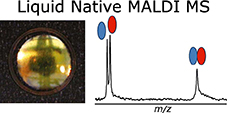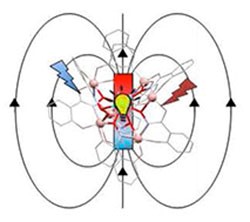The success of this method relies on the use of nonvolatile liquid matrices, which avoids the passage through the solid phase conventionally used in MALDI and the denaturation of the non-covalent assemblies. By their increased viscosity, these matrices also have the advantage of better mimicking the cluttered environments of living organisms.
The reliability of this method has been shown for non-covalent protein protein and ligand protein systems. This new approach could be used for screening of therapeutic protein ligands and facilitating the analysis of membrane protein complexes by mass spectrometry.
Catégorie d'actualités: significant publications
CBM researchers have worked out a new generation of metallacryptates
The first computational method to predict Rho-dependent termination of transcription.
MicroRNA-Based Drugs for Brain Tumors
Article in “Methods in Enzymology” by the team “Hélicases et ARN : mécanismes, ciblage et bio-mimétisme”
Molecular traps for DNA repair enzymes, a way for cancers and aging diseases therapies

Combining chemical synthesis of derivatives DNA molecules, designed to mimic small and large lesions, with comparative structural analysis of Fpg bound to damaged DNA, scientist from CBM have established the molecular basis for formation of an unproductive but stable complex between Fpg and the bulky DNA lesion. They suggest that formation of such abortive complex inhibits DNA repair processes, thus explaining the long persistence of these lesions observed in vivo their associated cell deleterious effects. Selective inhibition of Fpg and hOgg1 by bulky DNA lesions and their synthetic derivatives can, for example, be used for treating subjects having disorders associated either with excessive cell proliferation, such as in the treatment of various cancers, or with aging (degenerative diseases such as Alzheimer and Huntington).
References :
Coste, F., Ober, M., Le Bihan, Y.-V., Izquierdo, M.A., Hervouet, N., Carell, T. and Castaing, B. “Bacterial base excision repair enzyme Fpg recognizes bulky N7-substituted-FapydG lesion via unproductive binding mode.” Chemistry & Biology (2008) 15, 706-717
Illustration:

Publication of the book « Radiation chemistry: from basics to applications in material and life sciences »
Parution du livre “Radiation chemistry: from basics to applications in material and life sciences”
Editeurs: Spotheim-Maurizot, M; Mostafavi, M; Douky, T; Belloni, J
Collection: « L’actualité chimique Livres »
EDP Sciences, 307 pages
Illustrations en couleurs
Prix : 59 euros
This book gives a progress report on the many and original contributions of radiation chemistry to the fundamental knowledge of the vast domain of chemical reactions and its applications. Radiation chemistry techniques indeed make it possible to elucidate detailed physicochemical mechanisms in inorganic and organic chemistry (including in space) and in biochemistry. This comprehension is applied in materials science (radiopolymerisation, radiografting, specific treatment of surfaces, synthesis of complex nanomaterials, degradation of environmental pollutants and radioresistance of materials for nuclear reactors). In life sciences, the study of the effects of radiation on biomacromolecules (DNA, proteins, lipids) not only permits the comprehension of normal or pathological biological mechanisms, but also the improvement of our health. In particular, many advances in cancer radiotherapy, in the radioprotection of nuclear workers and the general population, as well as in the treatment of diseases and the radiosterilization of drugs, could be obtained thanks to this research.
Abundantly illustrated, this book contains 20 chapters written in English by top international specialists who have taken care to render the subjects accessible, this work will greatly interest those curious about a scientific field that is new to them and students attracted by the original and multidisciplinary aspects of the field. At a time when radiation chemistry research is experiencing spectacular development in numerous countries, this book will attract many newcomers to the field.
The book can be purchased from EDP Sciences, 17 Avenue du Hogar, BP 112, 91944 Les Ulis Cedex A, France.




